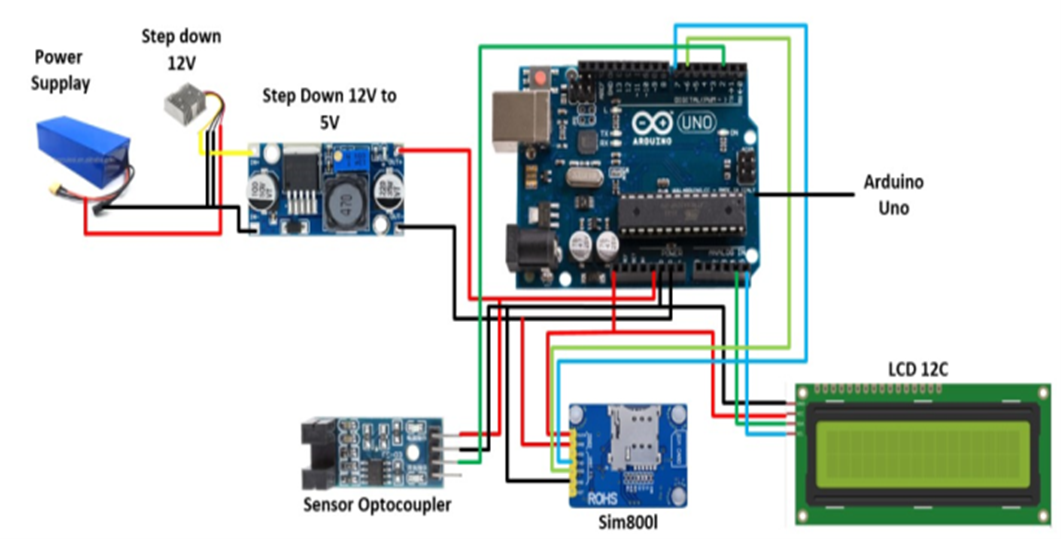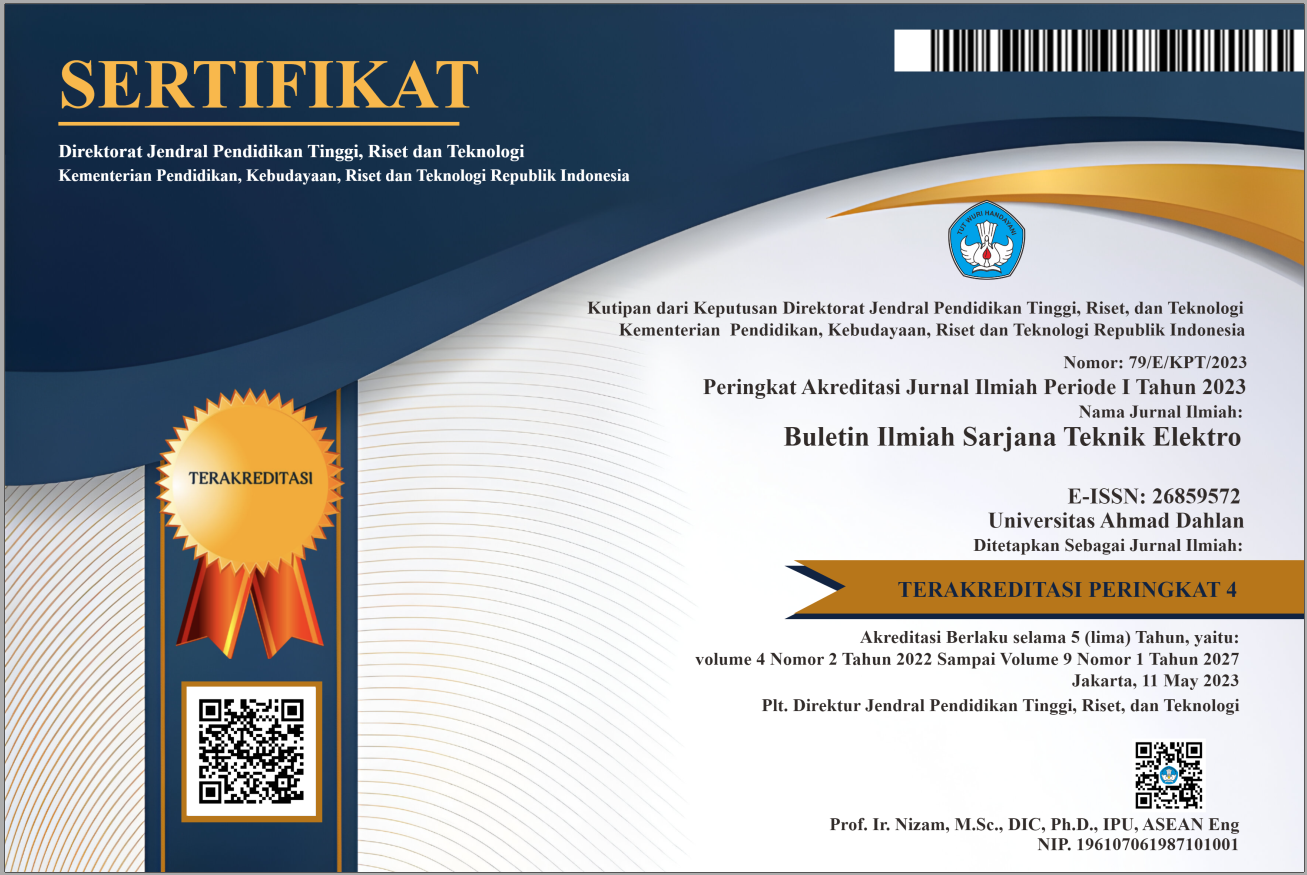Internet of Things (IoT) Based Speed Monitoring System for Electric Cars
DOI:
https://doi.org/10.12928/biste.v6i2.11317Keywords:
KMLI, Electric-Vehicle, Arduino, Internet of ThingsAbstract
The electric cars that have been made are also being competed at national events such as the FESC IIMS 2022 event in Jakarta and the Inter-College Electric Car Joint Training by the Ministry of Public Works and Public Housing (PUPR) in the context of the 2022 Road Day and the Indonesian Electric Car Contest (KMLI) at the Bandung State Polytechnic in Bandung until now. For the sustainability of electric cars, various research still needs to be carried out to achieve optimal electrical system design. Here, Ahmad Dahlan University's electric cars can operate at speeds above 30,000 rpm when monitored using a speedometer, but here there is no design for a long-distance speed monitoring system, therefore team colleagues who are in the paddock during the competition are not yet able to monitor the speed from inside the paddock. This system needs to be used during the race so that team mates in the paddock during the race can also monitor the speed of the Electric Car during the race when the race starts. This system is used using the Internet of Things (IoT) method because IoT can display speed data via a laptop and can implement a remote monitoring system. Therefore, in this final report, we will discuss how to design and implement a speed monitoring system for electric cars based on the Internet of Things (IoT). To get the best results and as expected, the design of this system refers to various sources. Where the input component is the detection from the Optocoupler Sensor after detecting the wheel speed, then the data is processed via Arduino using program initiation on the Arduino ide, after that the output will be generated on the I2C LCD and also the output will be displayed on IoT Things Speak because IoT itself, you have to use an internet signal, so here we add the sim800l component which is used to send Arduino data to Thingspeak via the sim800l internet intermediary. This tool was created with the aim of ensuring that the Al-Qorni UAD electric car continues to develop and has an advanced technological system.
References
I. Memon, M. K. Hasan, R. A. Shaikh, J. Nebhen, K. A. A. Bakar, E. Hossain, and M. H. Tunio, “Energy-efficient fuzzy management system for internet of things connected vehicular ad hoc networks,” Electronics, vol. 10, no. 9, p. 1068, 2021, https://doi.org/10.3390/electronics10091068.
X. Zhao, Y. Ye, J. Ma, P. Shi, and H. Chen, “Construction of electric vehicle driving cycle for studying electric vehicle energy consumption and equivalent emissions,” Environmental Science and Pollution Research, vol. 27, pp. 37395-37409, 2020, https://doi.org/10.1007/s11356-020-09094-4.
M. A. Hoque and C. Davidson, “Design and implementation of an IoT-based smart home security system,” International Journal of Networked and Distributed Computing, vol. 7, no. 2, pp. 85-92, 2019, https://doi.org/10.2991/ijndc.k.190326.004.
I. Husain et al., "Electric Drive Technology Trends, Challenges, and Opportunities for Future Electric Vehicles," in Proceedings of the IEEE, vol. 109, no. 6, pp. 1039-1059, 2021, https://doi.org/10.1109/JPROC.2020.3046112.
M. H. Lipu et al., “Intelligent algorithms and control strategies for battery management system in electric vehicles: Progress, challenges and future outlook,” Journal of Cleaner Production, vol. 292, p. 126044, 2021, https://doi.org/10.1016/j.jclepro.2021.126044.
M. Batra, J. McPhee, and N. L. Azad, “Real-time model predictive control of connected electric vehicles,” Vehicle System Dynamics, vol. 57, no. 11, pp. 1720-1743, 2019, https://doi.org/10.1080/00423114.2018.1552004.
H. Zhang and X. Lu, “Vehicle communication network in intelligent transportation system based on Internet of Things,” Computer Communications, vol. 160, pp. 799-806, 2020, https://doi.org/10.1016/j.comcom.2020.03.041.
F. Mohammadi and R. Rashidzadeh, "An Overview of IoT-Enabled Monitoring and Control Systems for Electric Vehicles," in IEEE Instrumentation & Measurement Magazine, vol. 24, no. 3, pp. 91-97, 2021, https://doi.org/10.1109/MIM.2021.9436092.
S. M. Shariff, M. S. Alam, F. Ahmad, Y. Rafat, M. S. J. Asghar and S. Khan, "System Design and Realization of a Solar-Powered Electric Vehicle Charging Station," in IEEE Systems Journal, vol. 14, no. 2, pp. 2748-2758, 2020, https://doi.org/10.1109/JSYST.2019.2931880.
A. Salam, “Internet of things for water sustainability,” In Internet of Things for Sustainable Community Development: Wireless Communications, Sensing, and Systems, pp. 113-145, 2024, https://doi.org/10.1007/978-3-031-62162-8_4.
D. Jiang, “The construction of smart city information system based on the Internet of Things and cloud computing,” Computer Communications, vol. 150, pp. 158-166, 2020, https://doi.org/10.1016/j.comcom.2019.10.035.
A. F. Subahi and K. E. Bouazza, "An Intelligent IoT-Based System Design for Controlling and Monitoring Greenhouse Temperature," in IEEE Access, vol. 8, pp. 125488-125500, 2020, https://doi.org/10.1109/ACCESS.2020.3007955.
J. -A. Jiang et al., "A Novel Sensor Placement Strategy for an IoT-Based Power Grid Monitoring System," in IEEE Internet of Things Journal, vol. 7, no. 8, pp. 7773-7782, 2020, https://doi.org/10.1109/JIOT.2020.2991610.
A. H. Mohd Aman, N. Shaari, and R. Ibrahim, “Internet of things energy system: Smart applications, technology advancement, and open issues,” International Journal of Energy Research, vol. 45, no. 6, pp. 8389-8419, 2021, https://doi.org/10.1002/er.6451.
M. K. Hasan, M. M. Ahmed, B. Pandey, H. Gohel, S. Islam, and I. F. Khalid, “Internet of Things‐Based Smart Electricity Monitoring and Control System Using Usage Data,” Wireless Communications and Mobile Computing, vol. 2021, no. 1, pp. 6544649, 2021, https://doi.org/10.1155/2021/6544649.
N. S. Lestari, A. G. Mahardika, T. Rachman, H. Suhendi, A. H. Mutaqin, and R. Hidayat, “Internet of Things Based Motorcycle Monitoring Application Development,” In Journal of Physics: Conference Series, vol. 1933, no. 1, p. 012098, 2021, https://doi.org/10.1088/1742-6596/1933/1/012098.
F. Behrendt, “Cycling the smart and sustainable city: analyzing EC policy documents on internet of things, mobility and transport, and smart cities,” Sustainability, vol. 11, no. 3, p. 763, 2019, https://doi.org/10.3390/su11030763.
M. A. P. Utomo, A. Aziz, and B. Harjito, “Server room temperature & humidity monitoring based on Internet of Thing (IoT),” In Journal of Physics: Conference Series, vol. 1306, no. 1, p. 012030, 2019, https://doi.org/10.1088/1742-6596/1306/1/012030.
A. A. Awirya, D. P. Sembiring, and B. Kreuta, “The potential development of electric motorcycles in remote areas case study: Agats District, Asmat Regency, Indonesia,” Cleaner Engineering and Technology, vol. 17, p. 100690, 2023, https://doi.org/10.1016/j.clet.2023.100690.
M. R. Djalal, I. Robandi and M. A. Prakasa, "Stability Enhancement of Sulselrabar Electricity System Using Mayfly Algorithm Based on Static Var Compensator and Multi-Band Power System Stabilizer PSS2B," in IEEE Access, vol. 11, pp. 57319-57340, 2023, https://doi.org/10.1109/ACCESS.2023.3283598.

Published
How to Cite
Issue
Section
License
Copyright (c) 2024 Rean Andhika Putra, Alfian Ma’arif

This work is licensed under a Creative Commons Attribution-ShareAlike 4.0 International License.
Authors who publish with this journal agree to the following terms:
- Authors retain copyright and grant the journal right of first publication with the work simultaneously licensed under a Creative Commons Attribution License that allows others to share the work with an acknowledgment of the work's authorship and initial publication in this journal.
- Authors are able to enter into separate, additional contractual arrangements for the non-exclusive distribution of the journal's published version of the work (e.g., post it to an institutional repository or publish it in a book), with an acknowledgment of its initial publication in this journal.
- Authors are permitted and encouraged to post their work online (e.g., in institutional repositories or on their website) prior to and during the submission process, as it can lead to productive exchanges, as well as earlier and greater citation of published work (See The Effect of Open Access).
This journal is licensed under a Creative Commons Attribution-ShareAlike 4.0 International License.


